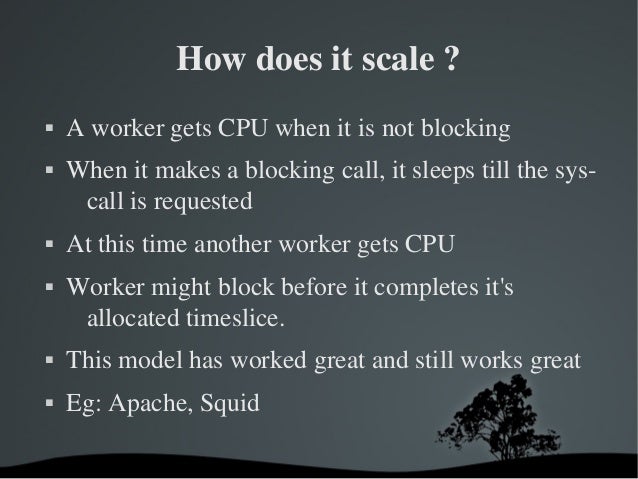Python Event Driven Seriale
- Concurrency in Python Tutorial
- Concurrency in Python Resources
- Selected Reading
- AWS Event Fork Pipelines helps you build event-driven serverless applications by providing pipelines for common event-handling requirements, such as event backup, analytics, and replay. The pipelines are based on AWS SAM, and can be deployed directly from AWS SAR into your AWS account.
- I'm looking for an answer for this question for a a few months, there is a c code design for QT to allow a serial port communication, one of it's features that allows to define an event driven serial read and wright, the code name is qextserialport and the code can be found here.
Event-driven programming depends upon an event loop that is always listening for the new incoming events. The working of event-driven programming is dependent upon events. Once an event loops, then events decide what to execute and in what order. Following flowchart will help you understand how this works − Python Module – Asyncio.
Event-driven programming focuses on events. Eventually, the flow of program depends upon events. Until now, we were dealing with either sequential or parallel execution model but the model having the concept of event-driven programming is called asynchronous model. Event-driven programming depends upon an event loop that is always listening for the new incoming events. The working of event-driven programming is dependent upon events. Once an event loops, then events decide what to execute and in what order. Following flowchart will help you understand how this works −

Python Module – Asyncio
Asyncio module was added in Python 3.4 and it provides infrastructure for writing single-threaded concurrent code using co-routines. Following are the different concepts used by the Asyncio module −
The event loop
Event-loop is a functionality to handle all the events in a computational code. It acts round the way during the execution of whole program and keeps track of the incoming and execution of events. The Asyncio module allows a single event loop per process. Followings are some methods provided by Asyncio module to manage an event loop −
loop = get_event_loop() − This method will provide the event loop for the current context.
loop.call_later(time_delay,callback,argument) − This method arranges for the callback that is to be called after the given time_delay seconds.
loop.call_soon(callback,argument) − This method arranges for a callback that is to be called as soon as possible. The callback is called after call_soon() returns and when the control returns to the event loop.
loop.time() − This method is used to return the current time according to the event loop’s internal clock.
asyncio.set_event_loop() − This method will set the event loop for the current context to the loop.
asyncio.new_event_loop() − This method will create and return a new event loop object.
loop.run_forever() − This method will run until stop() method is called.
Example
Python Serial Read Event Driven
The following example of event loop helps in printing hello world by using the get_event_loop() method. This example is taken from the Python official docs.
Output
Futures
This is compatible with the concurrent.futures.Future class that represents a computation that has not been accomplished. There are following differences between asyncio.futures.Future and concurrent.futures.Future −
result() and exception() methods do not take a timeout argument and raise an exception when the future isn’t done yet.
Callbacks registered with add_done_callback() are always called via the event loop’s call_soon().
asyncio.futures.Future class is not compatible with the wait() and as_completed() functions in the concurrent.futures package.
Example
The following is an example that will help you understand how to use asyncio.futures.future class.
Output
Coroutines
The concept of coroutines in Asyncio is similar to the concept of standard Thread object under threading module. This is the generalization of the subroutine concept. A coroutine can be suspended during the execution so that it waits for the external processing and returns from the point at which it had stopped when the external processing was done. The following two ways help us in implementing coroutines −
async def function()
This is a method for implementation of coroutines under Asyncio module. Following is a Python script for the same −
Output
@asyncio.coroutine decorator
Another method for implementation of coroutines is to utilize generators with the @asyncio.coroutine decorator. Following is a Python script for the same −
Output
Tasks
This subclass of Asyncio module is responsible for execution of coroutines within an event loop in parallel manner. Following Python script is an example of processing some tasks in parallel.
Output
Transports
Asyncio module provides transport classes for implementing various types of communication. These classes are not thread safe and always paired with a protocol instance after establishment of communication channel.
Following are distinct types of transports inherited from the BaseTransport −
ReadTransport − This is an interface for read-only transports.
WriteTransport − This is an interface for write-only transports.
DatagramTransport − This is an interface for sending the data.
BaseSubprocessTransport − Similar to BaseTransport class.
Followings are five distinct methods of BaseTransport class that are subsequently transient across the four transport types −
close() − It closes the transport.
is_closing() − This method will return true if the transport is closing or is already closed.transports.
get_extra_info(name, default = none) − This will give us some extra information about transport.
get_protocol() − This method will return the current protocol.
Protocols
Asyncio module provides base classes that you can subclass to implement your network protocols. Those classes are used in conjunction with transports; the protocol parses incoming data and asks for the writing of outgoing data, while the transport is responsible for the actual I/O and buffering. Following are three classes of Protocol −
Protocol − This is the base class for implementing streaming protocols for use with TCP and SSL transports.
DatagramProtocol − This is the base class for implementing datagram protocols for use with UDP transports..
SubprocessProtocol − This is the base class for implementing protocols communicating with child processes through a set of unidirectional pipes.
For information on what's new in Twisted 19.2.0, see the NEWS file that comes with the distribution.
What is this?
Twisted is an event-based framework for internet applications, supporting Python 2.7 and Python 3.5+.It includes modules for many different purposes, including the following:
twisted.web: HTTP clients and servers, HTML templating, and a WSGI servertwisted.conch: SSHv2 and Telnet clients and servers and terminal emulatorstwisted.words: Clients and servers for IRC, XMPP, and other IM protocolstwisted.mail: IMAPv4, POP3, SMTP clients and serverstwisted.positioning: Tools for communicating with NMEA-compatible GPS receiverstwisted.names: DNS client and tools for making your own DNS serverstwisted.trial: A unit testing framework that integrates well with Twisted-based code.
Twisted supports all major system event loops -- select (all platforms), poll (most POSIX platforms), epoll (Linux), kqueue (FreeBSD, macOS), IOCP (Windows), and various GUI event loops (GTK+2/3, Qt, wxWidgets).Third-party reactors can plug into Twisted, and provide support for additional event loops.
Installing
To install the latest version of Twisted using pip:
Additional instructions for installing this software are in the installation instructions.
Documentation and Support
Twisted's documentation is available from the Twisted Matrix website.This documentation contains how-tos, code examples, and an API reference.
Help is also available on the Twisted mailing list.

There is also a pair of very lively IRC channels, #twisted (for general Twisted questions) and #twisted.web (for Twisted Web), on chat.freenode.net.
Unit Tests
Twisted has a comprehensive test suite, which can be run by tox:
You can test running the test suite under the different reactors with the TWISTED_REACTOR environment variable:
Some of these tests may fail if you:
- don't have the dependencies required for a particular subsystem installed,
- have a firewall blocking some ports (or things like Multicast, which Linux NAT has shown itself to do), or
- run them as root.
Copyright
All of the code in this distribution is Copyright (c) 2001-2019 Twisted Matrix Laboratories.
Twisted is made available under the MIT license.The included LICENSE file describes this in detail.
Warranty
THIS SOFTWARE IS PROVIDED 'AS IS' WITHOUT WARRANTY OF ANY KIND, EITHEREXPRESSED OR IMPLIED, INCLUDING, BUT NOT LIMITED TO, THE IMPLIED WARRANTIESOF MERCHANTABILITY AND FITNESS FOR A PARTICULAR PURPOSE. THE ENTIRE RISK ASTO THE USE OF THIS SOFTWARE IS WITH YOU.
IN NO EVENT WILL ANY COPYRIGHT HOLDER, OR ANY OTHER PARTY WHO MAY MODIFYAND/OR REDISTRIBUTE THE LIBRARY, BE LIABLE TO YOU FOR ANY DAMAGES, EVEN IFSUCH HOLDER OR OTHER PARTY HAS BEEN ADVISED OF THE POSSIBILITY OF SUCHDAMAGES.
Again, see the included LICENSE file for specific legal details.